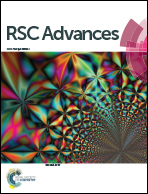Bio-based poly(lactide)/ethylene-co-vinyl acetate thermoplastic vulcanizates by dynamic crosslinking: structure vs. property
Abstract
Bio-based thermoplastic vulcanizates (TPV) from poly(lactide) (PLA) and ethylene-co-vinyl acetate rubber (EVA) were fabricated using dicumyl peroxide (DCP) as a curing agent; it is the first time that the application of PLA in elastic materials is demonstrated. A two-stage competing reaction mechanism as a function of peroxide content is revealed via gel analysis. The crosslinking of EVA is dominant at low DCP content (<1 wt%), which levels off when the DCP content exceeds 1 wt%. The gel fractions of the EVA and PLA phases can be tuned by the DCP content and fabrication technique. A desirable phase inversion of the PLA/EVA blends due to selective dynamic curing was monitored by both atomic force microscopy (AFM) and dynamic mechanical analysis (DMA). Consequently, PLA/EVA thermoplastic vulcanizates with high strength, high elongation at break, low tensile set and intermediate hardness were obtained. Moreover, their mechanical properties can be tuned by the DCP content and plasticization. The correlation between their structures and properties was investigated.


 Please wait while we load your content...
Please wait while we load your content...